- This news card is an excerpt from the original TH article.
- A superconductor is a substance that offers no resistance to electric current when it cools below a critical temperature.
- Aluminum, magnesium diboride, niobium, copper oxide, yttrium barium, and iron pnictides are some well-known superconductors.

What causes mercury to become a superconductor?
- Heike Kamerlingh Onnes, a Dutch physicist, discovered superconductivity in mercury in 1911.
- He discovered that solid mercury offers no resistance to the flow of electric current at a very low temperature, known as the threshold temperature.
What makes mercury capable of superconductivity?
- The Bardeen-Cooper-Schrieffer (BCS) theory provides an answer.
- Mercury was classified as a conventional superconductor by scientists because its superconductivity could be explained by Bardeen-Cooper-Schrieffer (BCS) theory concepts.
- While the BCS theory has been used to explain superconductivity in a variety of materials, scientists have never fully understood how it works in mercury, the oldest superconductor.
- The researchers used cutting-edge theoretical and computational approaches to discover that all physical properties relevant to conventional superconductivity in mercury are anomalous in some way.
How does BCS explain it?
- The vibrational energy released by the grid of atoms in BCS superconductors encourages electrons to pair up, forming so-called Cooper pairs.
- Below a certain temperature, these copper pairs can move like water in a stream, with no resistance to their flow.
- The group’s calculations provided a clearer picture of how superconductivity emerges in mercury by including previously overlooked factors.
- For example, by accounting for the relationship between an electron’s spin and momentum, the researchers were able to explain why mercury has such a low threshold temperature (around -270°C).
Coulomb repulsion and Mercury
- Similarly, the researchers discovered that one electron in each pair of mercury electrons occupied a higher energy level than the other.
- This detail is said to have reduced the Coulomb repulsion (like charges repel) between them, fostering superconductivity.
- As a result, the researchers have explained how mercury becomes a superconductor below its critical temperature.
- Their methods and findings imply that we may have overlooked similar anomalous effects in other materials, resulting in previously unknown ones that can be exploited for new and improved real-world applications.
Source: https://www.thehindu.com/sci-tech/science/a-clear-picture-of-how-mercury-becomes-a-superconductor/article66346400.ece
